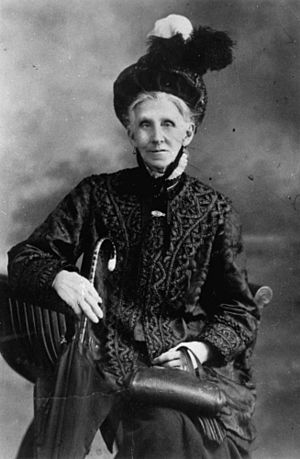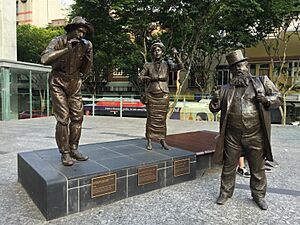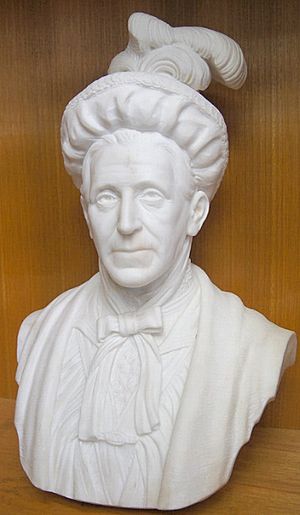Emma Miller facts for kids
Quick facts for kids
Emma Miller
|
|
|---|---|
 |
|
| Born |
Emma Holmes
26 June 1839 Chesterfield, England
|
| Died | 22 January 1917 (aged 77) Toowomba, Queensland, Australia
|
| Occupation | Trade union organiser and suffragist |
Emma Miller (born June 26, 1839 – died January 22, 1917) was an amazing woman born in England who became a leader in Australia. She helped start trade unions (groups that protect workers' rights) and fought for women's right to vote. She was also a very important person in the early days of the Australian Labor Party in Queensland, Australia.
Contents
Emma Miller's Early Life
Emma Miller was born in Chesterfield, England, in 1839. She was the oldest of four children. Her parents believed in Unitarian ideas and were active in the Chartist movement. The Chartists were a group that fought for more rights for ordinary working people in Britain.
When Emma was 18, she married Jabez Mycroft Silcock. They had four children. After Jabez died, Emma worked as a seamstress to support her family. In 1874, she married William Calderwood, and they moved to Queensland, Australia, in 1879 with Emma's children. William died soon after, in 1880. Emma then married Andrew Miller in 1886.
Fighting for Workers' Rights
In Queensland, Emma worked making shirts and sewing. She saw how hard women workers had it. In September 1890, she teamed up with May Jordan McConnel to create the first women's union in Brisbane, called the Brisbane Women's Union. This union helped women workers.
Emma spoke out about "sweatshops," which were places where people worked long hours for very little pay in bad conditions. She told a special government group in 1891 about how women were being treated unfairly. She also worked with the Early Closing Association, which wanted shops to close earlier so workers had more time off.
During the big strikes of the 1890s, Emma supported the 1891 Australian shearers' strike. She also helped set up a fund to support the families of strike leaders who were arrested. Many people called her "Mother Miller" because she was such a strong female leader in the workers' movement in Queensland. She helped start the Workers' Political Organisation, which later became the Australian Labor Party.
Winning the Right to Vote for Women
Emma Miller was a founding member of the Women's Equal Franchise Association in 1894. This group worked hard to get women the right to vote. Emma was elected president and stayed in that role until 1905.
Australia was a leader in women's voting rights. On April 9, 1902, women in Australia won the right to vote in national elections. This made them the first women in the world to vote for their country's parliament! (Women in New Zealand had won the right to vote in local elections earlier, in 1893).
Emma and her group encouraged women to vote in the December 1903 national election. They formed the Women Workers' Political Organisation, with Emma as president. Women in Queensland finally got the right to vote in their state parliament on January 25, 1905. The next year, Emma traveled all over western Queensland, giving speeches and helping to set up more groups for workers and women.
Later Years and Activism
The Brisbane General Strike
In 1912, there was a big strike in Brisbane called the 1912 Brisbane General Strike. Workers were fighting for the right to form trade unions. Emma Miller bravely led a group of women to Parliament House. During the march, police officers tried to stop them. Emma, showing her strong spirit, poked her hat-pin into a police commissioner's horse. This caused the horse to throw him off!
Working for Peace
Emma was also against conscription (forcing people to join the army) during World War I. She joined the Women's Peace Army in 1915 and became its president. She spoke out against war and helped lead a successful campaign to stop conscription in Australia in 1916. Many people believe that the strong efforts of women like Emma helped stop conscription.
Emma Miller's Death and Legacy
In January 1917, Emma Miller went to Toowoomba to rest. At her last public meeting, she told the women there how important it was for them to be part of the Labor movement. Two days later, Emma Miller passed away from cancer.
The flag at the Brisbane Trades Hall (a building for trade unions) was lowered to half-mast to honor her. She was called the "mother of the Australian Labor Party." The government offered a state funeral, but her son declined it. Emma Miller was buried at Toowong Cemetery.
Emma Miller's legacy lives on. In 1922, a marble statue of her was put up at the Queensland Council of Unions. There is also a statue of her in King George Square in Brisbane, and a place called Emma Miller Place. Since 1987, the Queensland Council of Unions has given out the Emma Miller Award every year to women who have made a great difference in their unions.
Her life story was shown in an exhibition in 2003. Also, a new voting area created in 2017 was named the electoral district of Miller in her honor.
See also
 In Spanish: Emma Miller para niños
In Spanish: Emma Miller para niños



